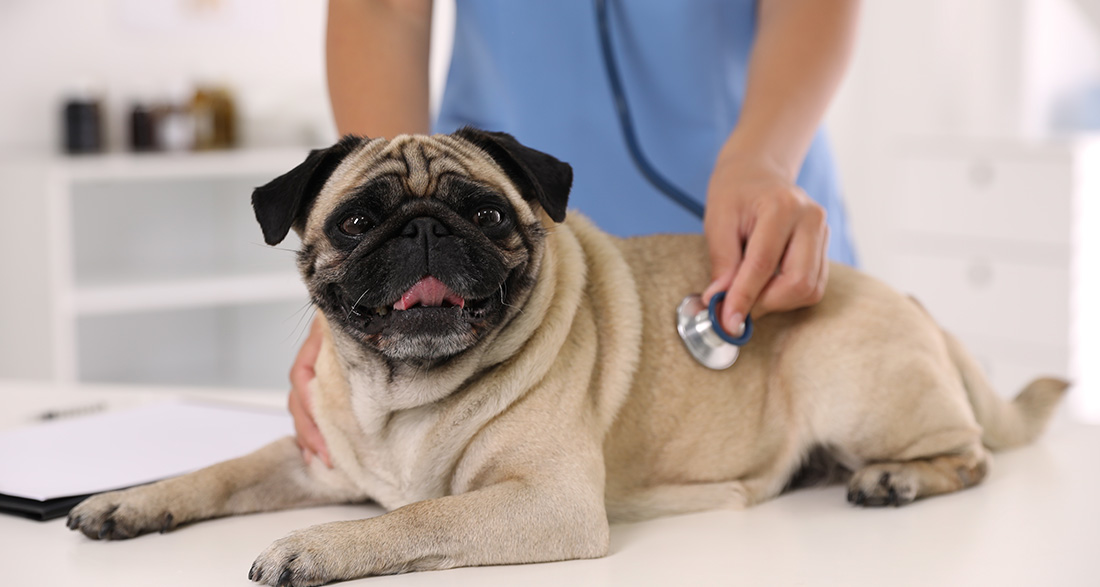Has your dog been unusually thirsty with increased urination lately? Is he suffering from hair loss or weakness? It could be Cushing’s syndrome, a condition characterized by an overproduction of cortisol, making your furry friend sick.
As it is not discernible for a layperson whether an animal is genuinely affected by the disease or just experiencing signs of aging, it is advisable to consult a veterinarian for any noticeable abnormalities. The veterinarian will initially ask various questions about your dog’s symptoms, and it’s crucial to answer them as accurately as possible, contributing to a precise diagnosis.
Subsequently, the veterinarian examines your pet’s skin and decides on further diagnostic tests, such as a urine or blood sample. Once the results confirm the suspicion of Cushing’s syndrome, your pet can be treated. With the help of medications, the dog’s condition and behavior usually improve within a few weeks. Eating and drinking habits, as well as energy levels, also normalize.
If Cushing’s syndrome is detected in its early stages, there is no need to worry. In such cases, your dog can have a high life expectancy despite the illness. Always take symptoms indicating an illness seriously, especially in older dogs, and schedule regular check-ups with the veterinarian.
Moreover, we recommend paying attention to high-quality dog food from the beginning. This forms an essential basis for keeping your pet fit well into its senior years. While healthy dog food may not prevent all diseases, it enhances resilience and can assist your pet in overcoming illnesses.
To help you better assess whether your pet is suffering from Cushing’s syndrome, this article explains the background and symptoms of the disease. Additionally, various treatment options are presented.
Understanding Cushing’s Syndrome
Cushing’s syndrome is a disease involving hormonal imbalance, also known as hyperadrenocorticism. It is characterized by excessive cortisol production. Cortisol release is essential for your pet’s body as it regulates blood pressure and sugar metabolism.
However, when produced in excessive amounts, it creates an imbalance in the hormone system, favoring infectious and sugar-related diseases. Without Cushing’s syndrome treatment, issues such as trembling, thirst, or hair loss occur, leading to the dog’s death over time.
In the final stage of Cushing’s syndrome in dogs, the animal becomes very lethargic. For instance, it might struggle to get into the car or face difficulties with activities like fetching a stick, leading to respiratory problems.
When timely and professionally treated, the disease is not life-threatening. The dog’s vitality returns with the appropriate medication, and you can resume playing fetch and going on outings together.
Cushing’s syndrome in dogs is primarily attributed to a tumor, not an allergy. Often, this tumor is located in the brain and is benign. Nevertheless, it prompts the adrenal glands to continue producing cortisol, even when there is already enough in your pet’s body.
Sometimes the tumor directly affects the adrenal glands, although this occurs less frequently. Caution is especially advised if your dog is already being treated with steroids. Inform the veterinarian before treatment, as they can assist in adjusting the medication dosage accordingly.
Older dogs, especially certain breeds like Dachshunds, Terriers, Boxers, Poodles, and Schnauzers, are more prone to Cushing’s syndrome. If your pet belongs to one of these breeds, keep a close eye on it in its advanced age.

Typical Symptoms of Cushing’s Syndrome in Dogs
Just like every human reacts differently to an illness, every animal, including dogs, may show unique responses. As a dog owner, it may not be straightforward to determine if your canine companion is genuinely suffering from Cushing’s syndrome. However, there are some signs that indicate a potential issue.
Dogs with Cushing’s syndrome may exhibit the following symptoms:
- Increased Thirst: While dogs may drink more water in hot weather, sudden and excessive thirst without an apparent reason should be taken seriously.
- Hair Loss: Affected animals often experience hair loss, affecting either specific regions or nearly the entire body. Areas like the head or back may be particularly affected. Additionally, the skin might become thinner, and wound healing could be slow.
- Breathing Issues: Increased panting may be noticeable, and your dog might become more susceptible to infections.
- Lethargy: If your dog behaves differently, lies down frequently, appears tired, and lacks endurance, it may indicate an underlying issue.
- Trembling: Dogs with Cushing’s syndrome might exhibit trembling, especially when in motion. Muscle tone disturbances are also typical.
Pay attention if you observe any of these symptoms in your dog. The disease is often not detected until some time has passed, but the earlier you begin treatment, the better the chances of success. If left undetected for an extended period, it can affect other areas of the body.
Moreover, increased susceptibility to infections can lead to additional health issues. In particular, thyroid diseases in dogs can weaken the immune system. Additional illnesses pose a significant burden on your pet and can rapidly reduce life expectancy. Do not simply attribute physical changes to the aging process; monitor your pet’s vitality closely.

Treatment of Cushing’s Syndrome in Dogs
Cushing’s syndrome in dogs can be life-threatening. Therefore, it is crucial to consult a veterinarian promptly if there is suspicion of the disease, especially if your dog is suffering from IBD or another chronic illness. The weaker your pet’s vitality, the more challenging it may be to handle additional burdens.
Both medical and surgical treatments are generally available. The veterinarian decides on the appropriate approach after a thorough examination, including blood and urine tests. An adrenocorticotropic hormone (ACTH) test, involving the injection of a substance to analyze cortisol production, is also a diagnostic option.
Usually, attempts are made to stabilize your pet’s hormone levels with medications initially. If there is an adrenal gland disorder, removing the tumor through surgery is a possibility. Subsequently, your dog may need pain medication.
Although the disease is not entirely curable, treatments are often successful. Your beloved pet regains vitality and joy. With regular administration of prescribed medications, dogs with Cushing’s syndrome can have a long life expectancy, provided they tolerate the medications well.
Sometimes, it takes a while for the treatment to take effect, and in some cases, the intolerance may be so significant that the animal cannot be helped.
In addition to veterinary treatment, proper nutrition is indispensable for your dog’s health. It should be easily digestible and relieve the liver. Since food intolerance is common in dogs, comprehensive advice from your veterinarian is essential. They have experience from treating other dogs and can provide excellent recommendations.
Furthermore, do not forget to schedule regular veterinary check-ups for your pet. If your pet’s condition worsens, the veterinarian can intervene early.
Boost Your Dog’s Vitality
We care deeply about ensuring your pet enjoys life well into old age. Therefore, we recommend Anifit pet food. All products from this manufacturer are produced in Sweden, known for their high quality and food-grade standards. The absence of added fats additionally supports your pet’s vitality.
Nutrition strongly influences a dog’s health, just as it does for humans. Anifit is aware of its responsibility and aims to help you supply your pet with essential nutrients. Therefore, Anifit uses natural ingredients for its products—a quality feature to always look for when making a purchase.
Moreover, ensure that your dog gets sufficient exercise. The required amount depends on the breed and age. If you are unsure, consult with your veterinarian. Additionally, allow your dog to explore new environments regularly. Many dogs enjoy outings.
Social interactions are equally important. Dogs appreciate it when their owners give them plenty of attention. Make your pet feel loved through petting and cuddling. Regular contact with fellow dogs is also necessary for long-term happiness.
Lastly, take care of your dog’s teeth and coat. Regularly check for ticks to prevent potential dangers, as they can be as harmful as Cushing’s syndrome. To maintain dental health, brush your pet’s teeth daily and provide chew toys.
With regular veterinary check-ups and your care, the chances are good that your pet will remain vital well into old age.


